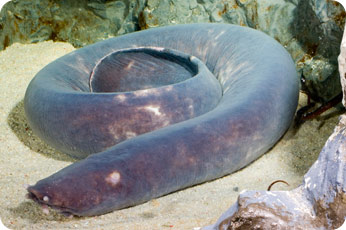From its name to its feeding habits, the hagfish is one of the least appealing creatures in the sea.
 The hagfish-one of the least appealing creatures in the sea. Credit: Dr. Paddy Ryan www.ryanphotographic.com.
The hagfish-one of the least appealing creatures in the sea. Credit: Dr. Paddy Ryan www.ryanphotographic.com.Its long, thin body looks like a fat worm -- and early researchers even classified it as a worm. It burrows into the ooze at the bottom of the ocean, usually waiting for a dead or dying animal to fall from above. And when one does, it burrows into the creature and eats it from the inside out.
But things get really gross when you consider its nickname: slime eel. It’s not really an eel, but it is slimy. It can quickly coat itself with sticky slime. That coating was commemorated in the hagfish’s Latin name, Myxine glutinosa, which means “sticky slime.”
The hagfish has slime glands all along its body, which is generally about a foot and a half long. When it’s frightened or provoked, those glands pump out massive amounts of slime. When the slime mixes with seawater, it forms a thick “cocoon” that can completely cover the fish.
The slime can make the little guys too slick to catch. And when a predator does get one, the slime may gunk up its gills, causing it to suffocate.
Despite its nastiness, the hagfish is an important test subject for scientists. It’s actually a distant relative to humans, so researchers have studied many of its bodily functions to learn more about our own bodies.
And the slime is important, too. It contains long fibers that are as thin and tough as spider silk. Researchers hope that studying these fibers may someday lead to artificial fibers that are strong and flexible -- but not slimy.

